STARTING YOUR PATH
All young athletes aspire to reach the highest levels of the sport they love because it's in their DNA to be competitive and to push themselves as far as they can go. In sports like basketball, soccer, lacrosse, volleyball, softball and so on, players can go in one direction as far as they're able to make it through travel sports and high school sports, and for the best of the best, into college sports and potentially beyond.
Hockey is unlike any other sport because there isn't one path to follow as far as it will take you. It requires a great deal of education about the different options and the process, and also takes careful planning to get on the right track. While classmates who play other sports can look at the next step up as their goal - moving from a B team to an A team, moving from JV to Varsity, etc. - hockey players have to make strategic decisions based on long-term goals.
It's not like climbing a ladder. It's more like choosing your path.
The first step in getting started down your path is to set a SMART goal, which can be done by using the template linked above. The process of setting a SMART goal won't just help plot out a plan to achieve your goal, it will also fine-tune your goal to help choose the right path for you.
The two most difficult, but most important components of the SMART goal process are the A - Attainable and R - Relevant steps of the process.
No matter the level, there are two universal truths about the opportunity to play college hockey:
- You have to be good enough to earn a spot on the team
- You have to be able to get into the school
Does your goal realistically match your ability or potential as a hockey player? Does your goal realistically match your ability as a student?
It's also crucial to ask "does my hockey goal line up with my life goals?"
You may say your goal is to play Division I hockey. Did you spend your offseason in the gym? Are you spending extra time with your coaches watching film to better understand the game? If not, your priorities are telling you to revise your goal.
If you have goals to attend a specific college or if it's important to you to begin your Freshman year right after high school, your life goals are telling you to revise your hockey goals.
And that's perfectly fine! The SMART goal process is all about focusing on what you want to do, and also what you're willing to do to get there.
It can also help you make sure that you're on the right path, which in hockey can save you thousands and thousands of dollars.
It's very tempting to get distracted by the rush and the thrill of a coach telling you "You're a great player, I want you to come play for me and I'll give you the opportunity you're looking for." Unfortunately, in our sport, a high percentage of these "opportunities" aren't anywhere close to being aligned with a player's goals, and in some cases, these paths just lead to a dead end.
Use this guide as your GPS.
Setting your destination is key, but so is finding the shortest way there.
By knowing which hockey goals are relevant to your life goals, and by knowing which steps along the way are relevant to the end goal, players and families are set up for success no matter where the path leads.
In this guide, you will find
- An honest overview of the different levels of post-youth hockey
- The path players should expect to follow in pursuit of their goals
- Links to resources to learn more on your own
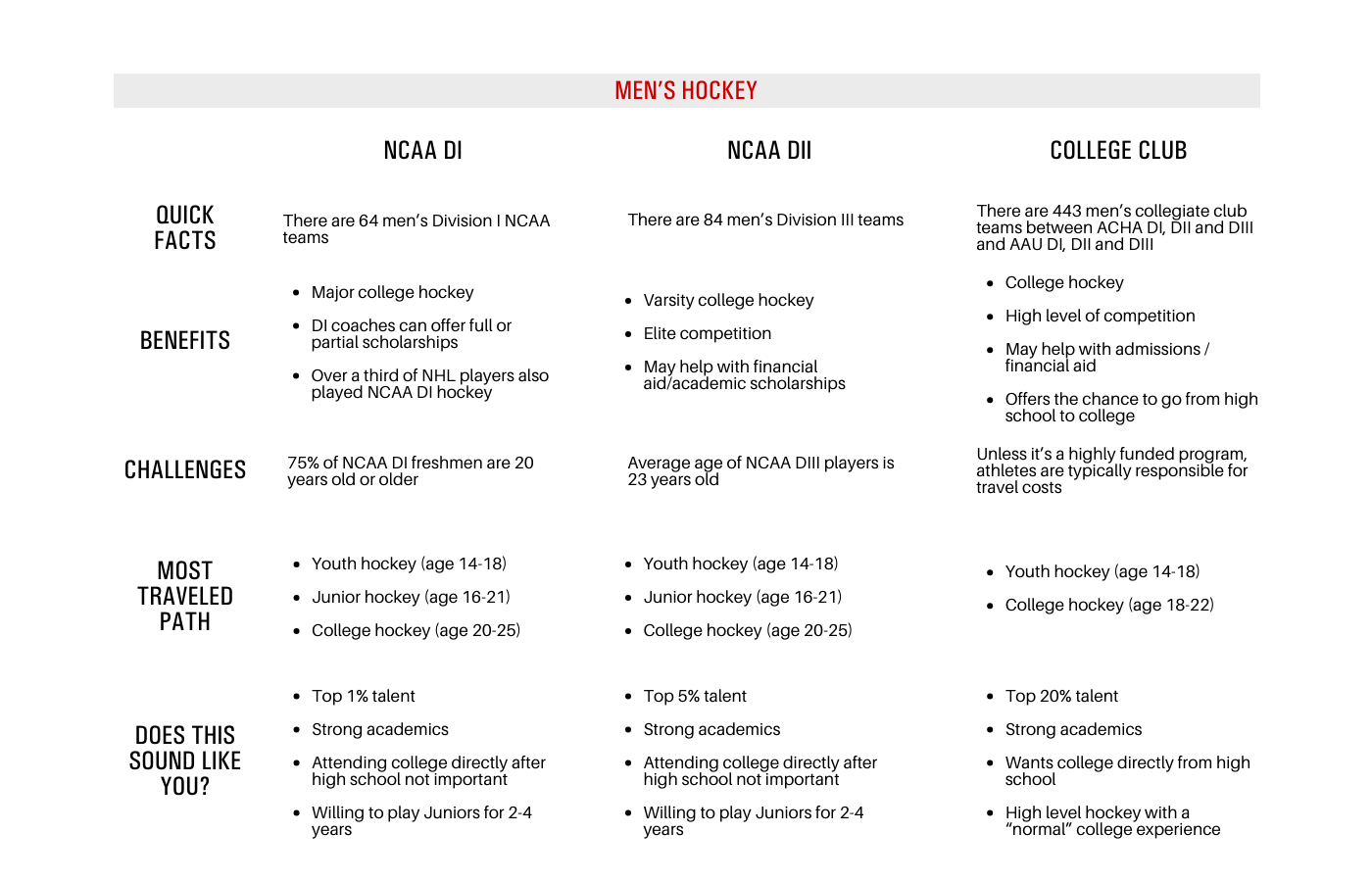
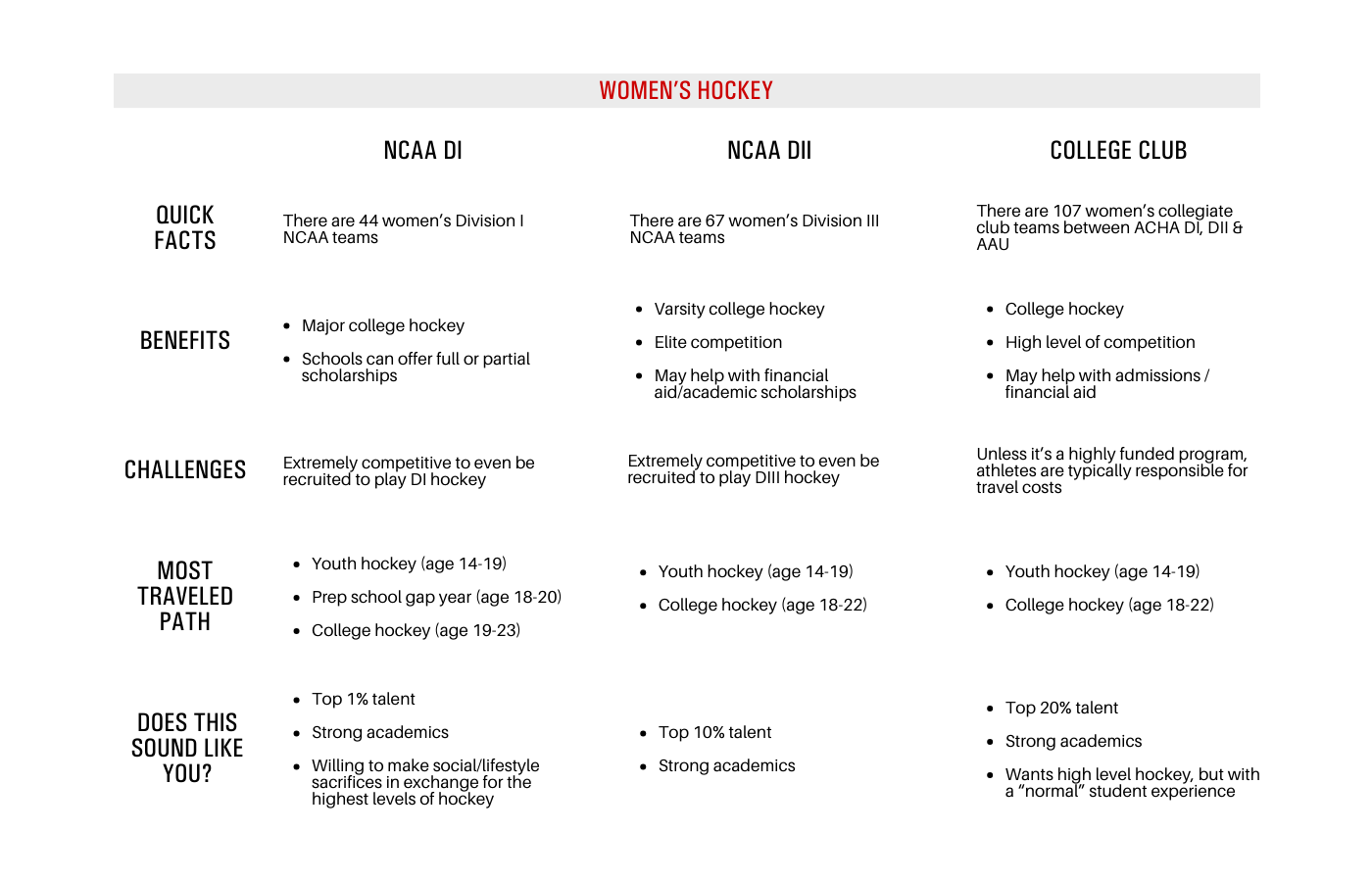
COLLEGE HOCKEY
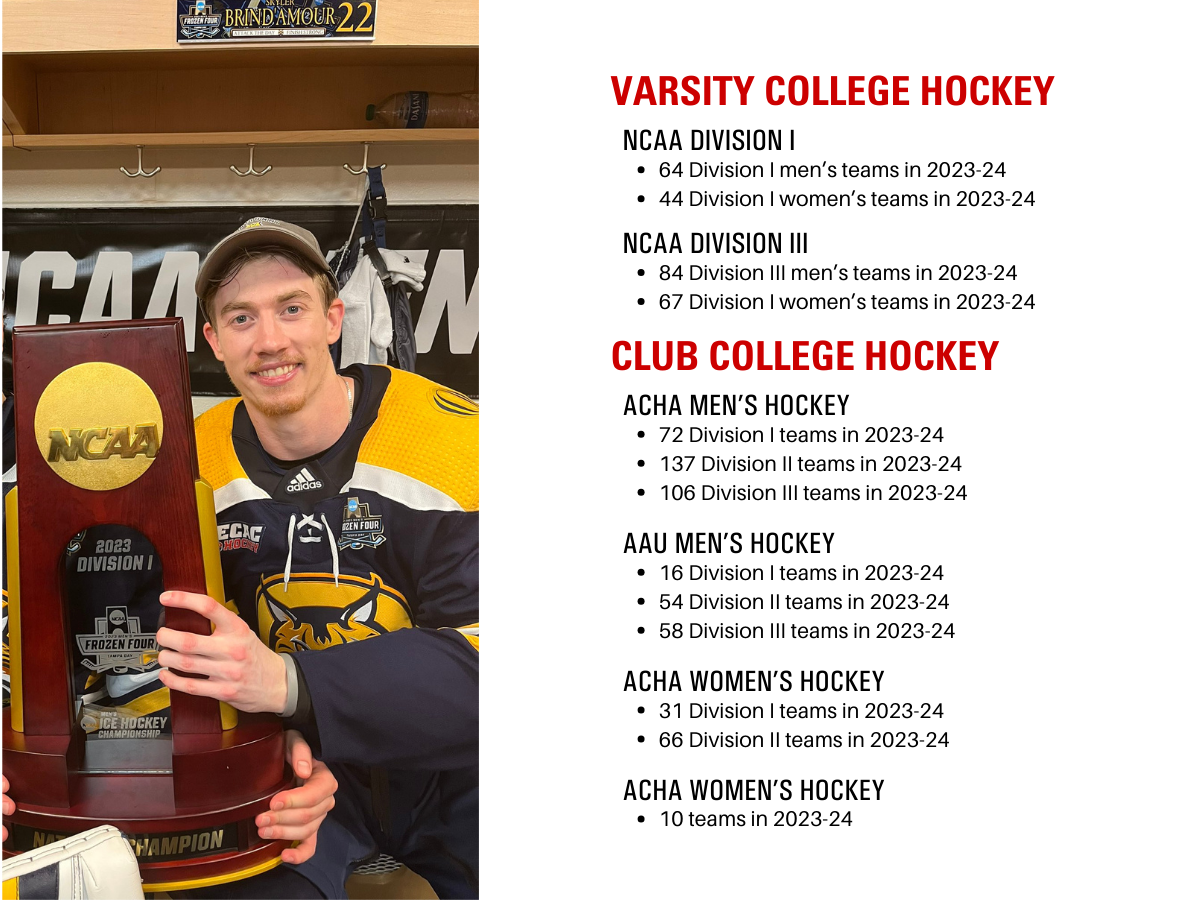
UNDERSTANDING THE LEVELS OF COLLEGE HOCKEY
There are two levels to collegiate men's and women's hockey: varsity, and club.
Varsity teams are financially backed by the school's athletic department, are governed by the NCAA, and in the case of Division I hockey, coaches are able to offer athletic scholarships.
Division I men's and women's teams are allowed a maximum of 18 full scholarship equivalents, but with no limits on the number of players teams can roster, full scholarship awards are rare.
Division III schools do not award athletic scholarships, but schools can utilize academic scholarship money for exceptional athletes who are also exceptional students.
Club teams can be entirely self-funded through a combination of membership dues, sponsorships, ticket and apparel sales and donations, or can also be subsidized by the school's athletic or student activity budget.
There are two main governing bodies for intercollegiate club hockey ... the American Collegiate Hockey Association (ACHA) and AAU College Hockey.
The ACHA is larger and more established, offering Division I, II & III men's hockey and Division I & II women's hockey. The AAU (formerly College Hockey Federation) fairly recently broke away from the ACHA and currently offers Division I, II & III men's hockey, and Division I women's hockey.
MYTH: MANY PLAYERS HAVE A GOAL TO GET TO JUNIOR HOCKEY
FACT: The sole purpose of Junior hockey is advancement to the next Tier of Juniors or advancement to an NCAA roster, so if there isn't a goal beyond Junior hockey, players should not consider Juniors as a part of their path. If a player does have a goal to play professional or NCAA men's hockey, Juniors is a necessity, not a goal.
MYTH: I HAVE TO PLAY TIER I AAA HOCKEY OR PREP SCHOOL TO GET SEEN
FACT: There's only one place where a player needs to be to get seen ... on the ice.
Far too often, players will leave a happy situation with a successful team and loads of ice time to "climb the ladder" to sit the bench for another team just because it feels as if they're advancing. A good rule of thumb is that a player shouldn't even consider moving up a level until they've reached a point where they are dominating their current level.
Even more common is the situation where a player "advances" to a Tier I AAA team or a prep school team that's a weaker team with fewer opportunities for development or advancement than they one they left behind.
Before jumping at the chance to say you play AAA hockey or prep school hockey, utilize two great resources to evaluate the opportunity:
MyHockeyRankings.com will show you what a team is ranked, who they compete against, and the competitive strength of any leagues they might be members of.
EliteProspects.com will show you where former players have advanced to in the "Where are they now" section of a team's profile.
If a AAA team or prep school team is ranked 80+ and has sent their alums to Tier III Juniors and/or ACHA or CHF/AAU college club teams, that's the general profile of our Tier II AA 18U teams.
MYTH: IT'S A MISTAKE TO LEAVE HOME TO PURSUE HOCKEY UNLESS I "MAKE IT"
FACT: Every player runs their own race. Leaving home for a great opportunity that doesn't pan out isn't a mistake. Only a small few ever get to advance to the higher levels of the game. The only mistake is making a move that either doesn't help you, or that you're only making because you feel like you have to and not because you want to.
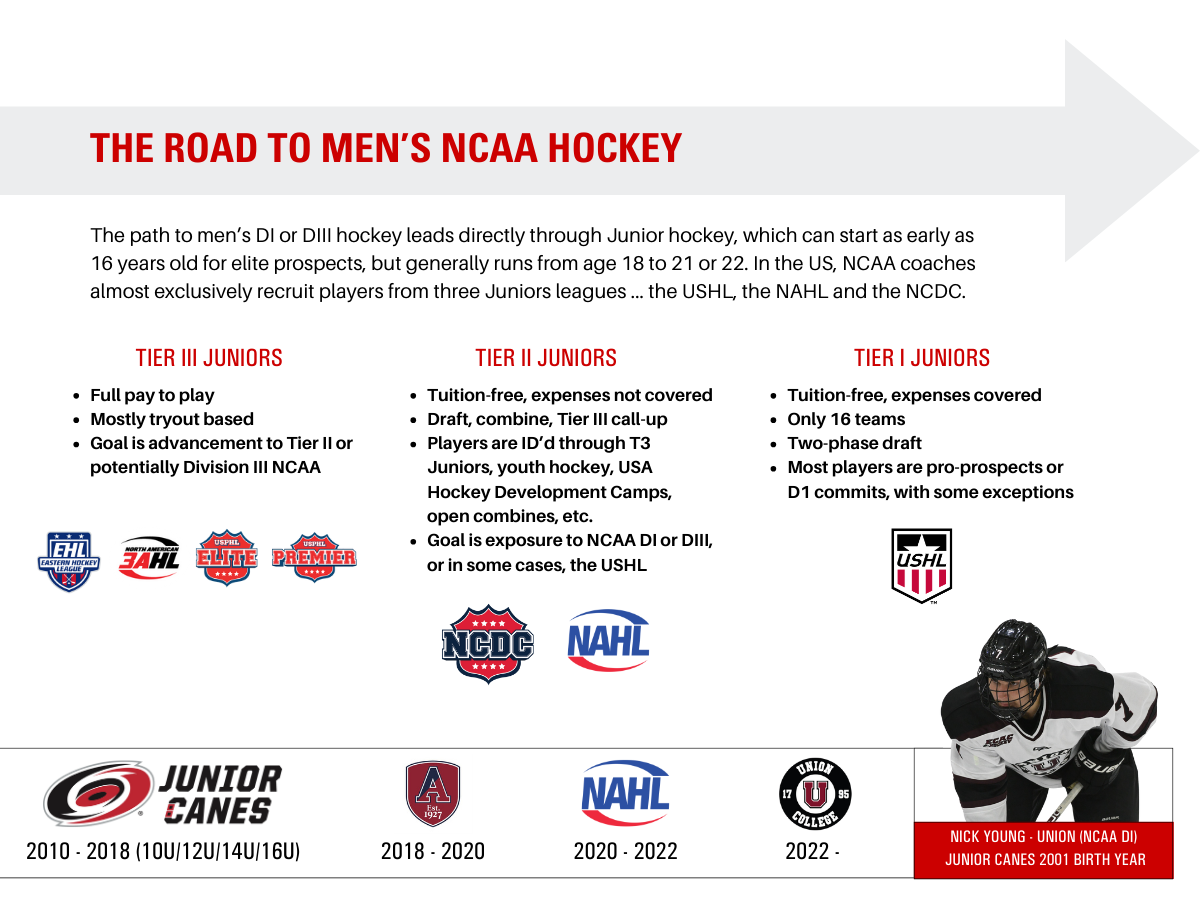
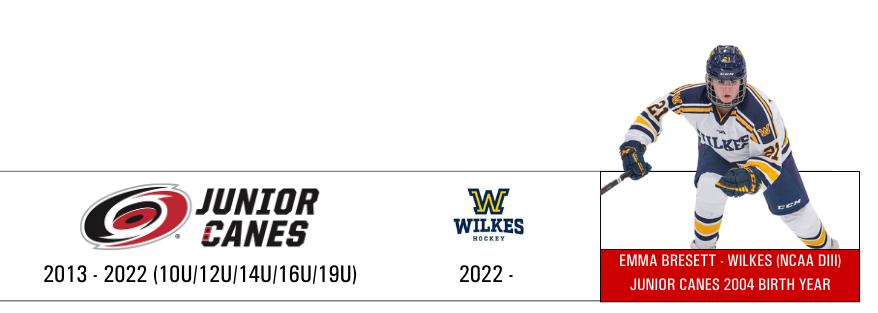
WOMEN'S NCAA HOCKEY
Without Junior hockey, the youth hockey-to-college hockey path is very different for female athletes, but equally if not more competitive.
Women's hockey follows a much more traditional route where coaches are recruiting high school athletes. Players rely heavily on their coaches - and on themselves - to proactively build relationships with college coaches to get on their radar.
NCAA Division I and Division III teams are heavily concentrated in the Northeast and Midwest, so for athletes in North Carolina, game film is a critical tool. Showcase events and participation in the USA Hockey Player Development are extremely important to get on the ice in front of college coaches who you've been in contact with to express your interest in being recruited.
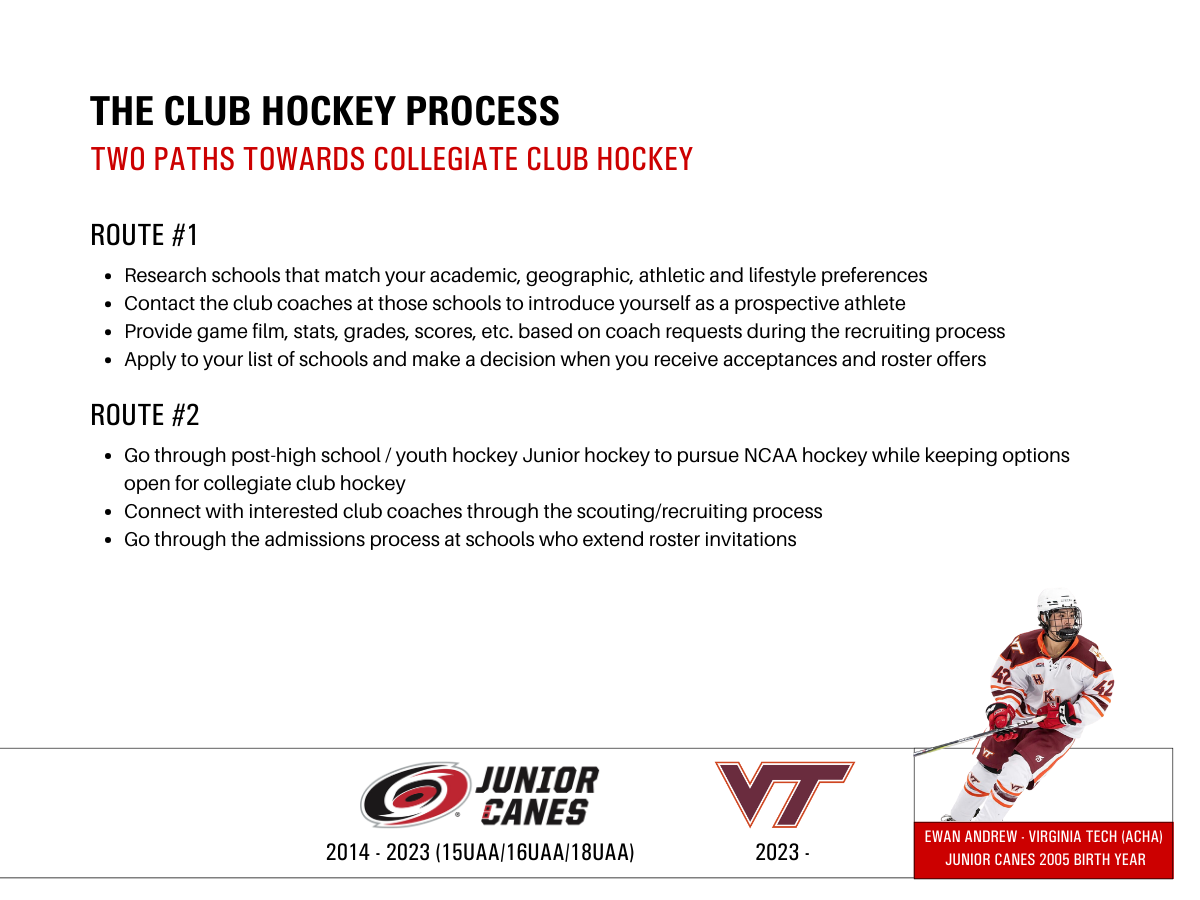
THE CASE FOR CLUB HOCKEY
Being a college varsity athlete isn't for everyone. Athletic commitments take their toll on the experience that college students traditionally go through, and in the case of hockey, the extended Junior hockey grind is a turn off to many elite-level hockey players who don't want to be a 20+ year old freshman.
HIGH LEVEL COMPETITION
Club hockey is not recreational hockey. While sports like basketball, soccer and so on offer extensive opportunities at the Division I ,II and III varsity levels, hockey does not. The level of talent is easily comparable to varsity athletes in other sports, and in some cases, comparable to varsity hockey athletes. Top club teams frequently will play pre-season exhibitions against NCAA teams.
FAN SUPPORT
Depending on the school, club hockey will be one of the most popular spectator sports on campus. College Hockey South, an AAU league with member schools more known for SEC football or the southern part of the ACC footprint, boast that club hockey programs are overtaking baseball as the third most highly-attended sports at their schools. Locally, NC State easily fills the 2000+ seat Invisalign Arena ... when they aren't busy drawing 10,000 fans at Carter-Finley Stadium.
HOME COOKING
Stevenson University in Maryland is the only NCAA varsity program in the Southeast or the Mid-Atlantic (DIII Men's & Women's Hockey). There are nearly 100 men's and women's club hockey teams within that same footprint.
JUNIOR CANES ALUMNI


